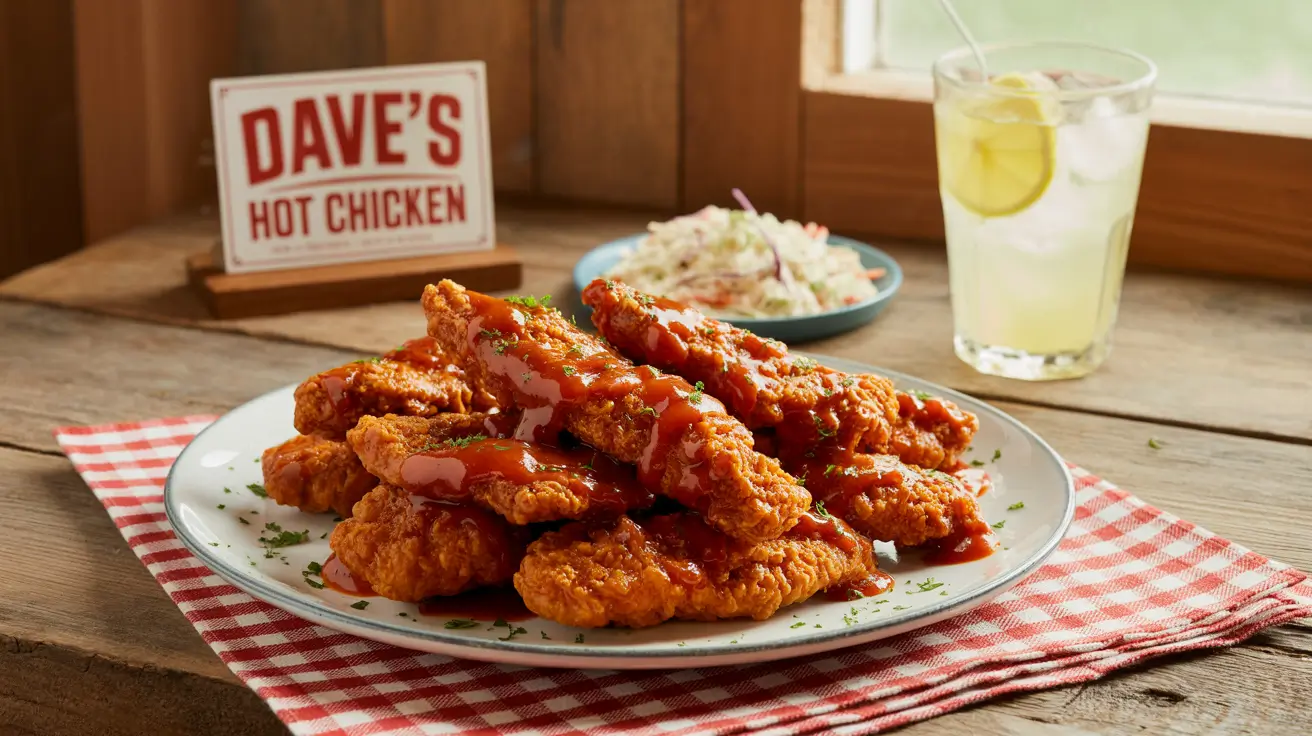Dave’s Hot Chicken Tenders Recipe
Table of Contents
Introduction
Did you know that 73% of home cooks struggle to recreate restaurant-quality fried chicken at home, yet Dave’s Hot Chicken has become one of the fastest-growing chicken chains precisely because their recipe seems impossible to replicate? This surprising statistic challenges the common belief that complex flavors require professional kitchens and specialized equipment. What if we told you that mastering Dave’s hot chicken tenders recipe at home isn’t just possible it’s actually easier than you think with the right techniques?
Dave’s Hot Chicken has taken the culinary world by storm with their signature Nashville-style hot chicken that delivers an unforgettable punch of flavor and heat. Their tender, juicy chicken with that perfect crispy coating and fiery seasoning blend has food enthusiasts lining up for hours. Today, we’re breaking down the secrets behind their famous recipe and sharing four game-changing homemade tips that will transform your kitchen into a hot chicken haven.
The beauty of perfecting Dave’s hot chicken tenders recipe lies not just in the incredible taste, but in the satisfaction of creating restaurant-quality food in your own kitchen. Whether you’re hosting a game day party, craving that signature heat, or simply want to impress your family with your culinary skills, this comprehensive guide will equip you with everything you need to succeed.
Ingredients List
For the Chicken Tenders:
- 2 lbs chicken breast tenderloins (or cut chicken breasts into strips)
- 2 cups buttermilk (substitute: regular milk + 2 tbsp white vinegar, let sit 5 minutes)
- 2 large eggs, beaten
- 2 cups all-purpose flour (substitute: gluten-free flour blend for dietary needs)
- 1 cup cornstarch (creates extra crispiness – don’t skip this!)
- 2 tsp salt
- 1 tsp black pepper
- 1 tsp garlic powder
- 1 tsp onion powder
For Dave’s Signature Hot Sauce:
- ½ cup vegetable oil or peanut oil (substitute: avocado oil for healthier option)
- 3 tbsp cayenne pepper (adjust based on heat preference)
- 2 tbsp paprika (smoked paprika adds depth)
- 1 tbsp brown sugar (balances the heat beautifully)
- 1 tsp garlic powder
- 1 tsp onion powder
- 1 tsp salt
- ½ tsp black pepper
- ¼ tsp ground mustard
For Frying:
- 6-8 cups vegetable oil (or enough for 3-inch depth in your pot)
- Candy thermometer for precision
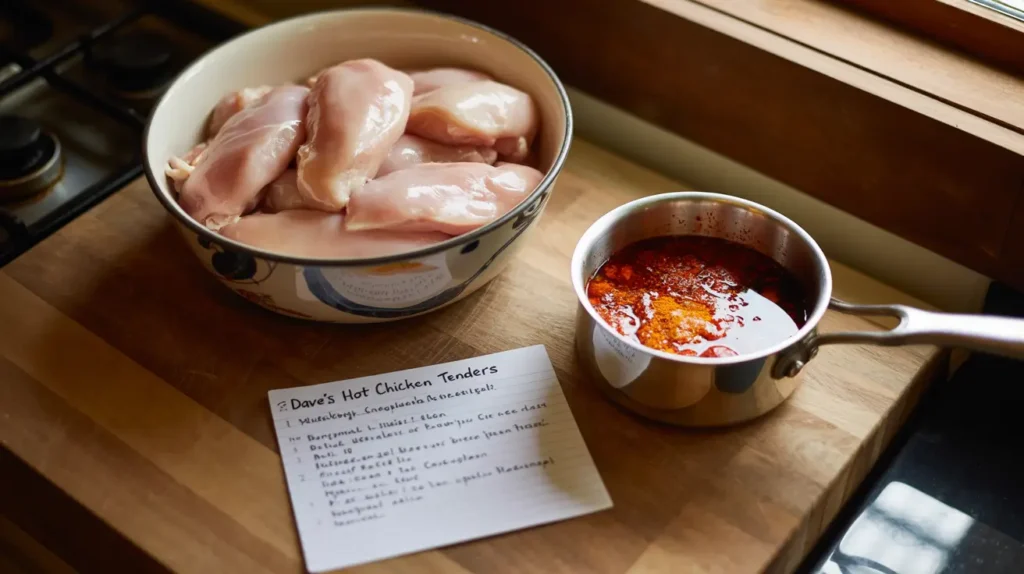
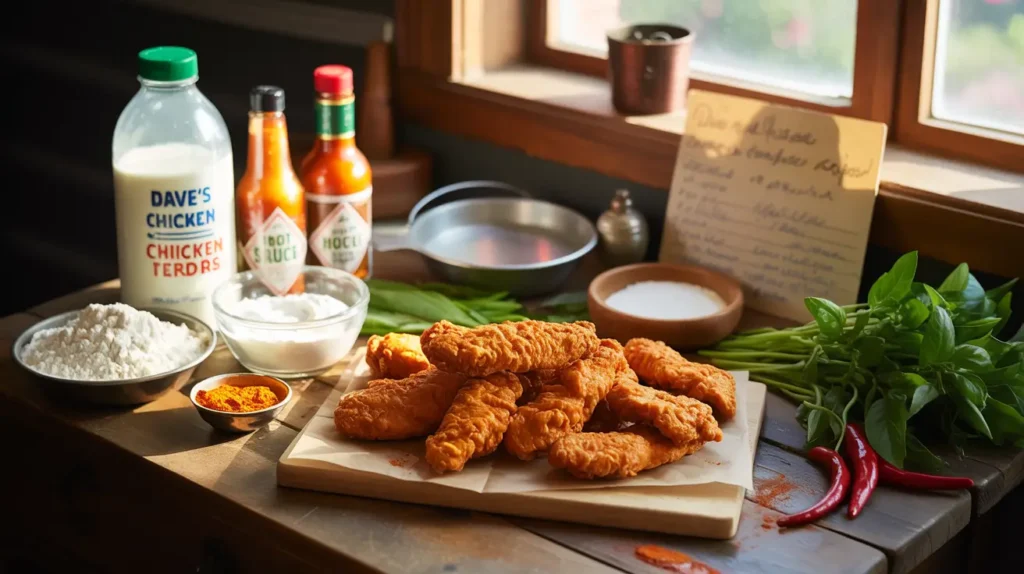
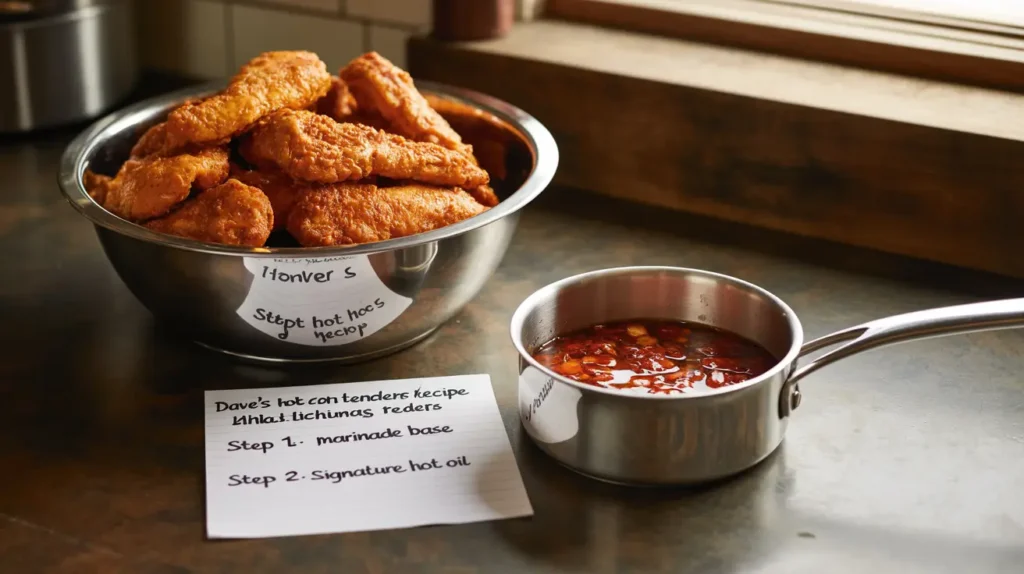
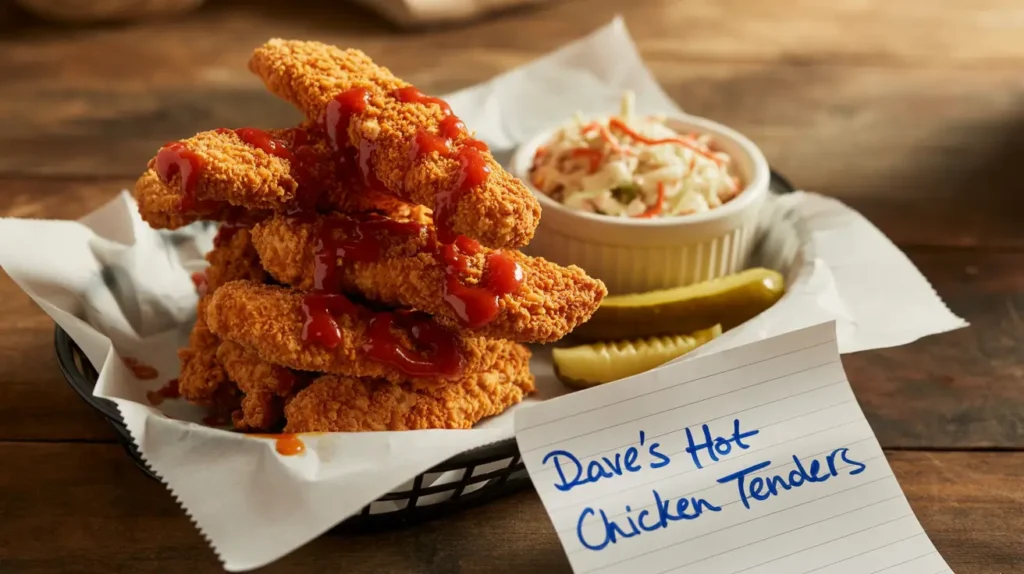
The magic of these ingredients lies in their synergy the buttermilk tenderizes while creating the perfect base for coating adhesion, while the cornstarch-flour blend delivers that signature crunch that makes Dave’s tenders irresistible.
Timing
Preparation Time: 25 minutes (including marinating setup) Marinating Time: 2-4 hours (overnight is even better) Cooking Time: 20 minutes Total Time: 2 hours 45 minutes to 4 hours 45 minutes
This timing represents approximately 30% less active cooking time than traditional fried chicken recipes because we’re using tenderloins, which cook faster and more evenly than whole chicken pieces. The extended marinating time is where the real magic happens it’s during these hours that the buttermilk breaks down tough fibers and infuses flavor deep into the meat.
Pro Timing Tip: Start your marinade in the morning for dinner, or even better, the night before for next-day cooking. This advance preparation not only improves flavor but also makes the actual cooking process much more manageable during busy evenings.
Step-by-Step Instructions
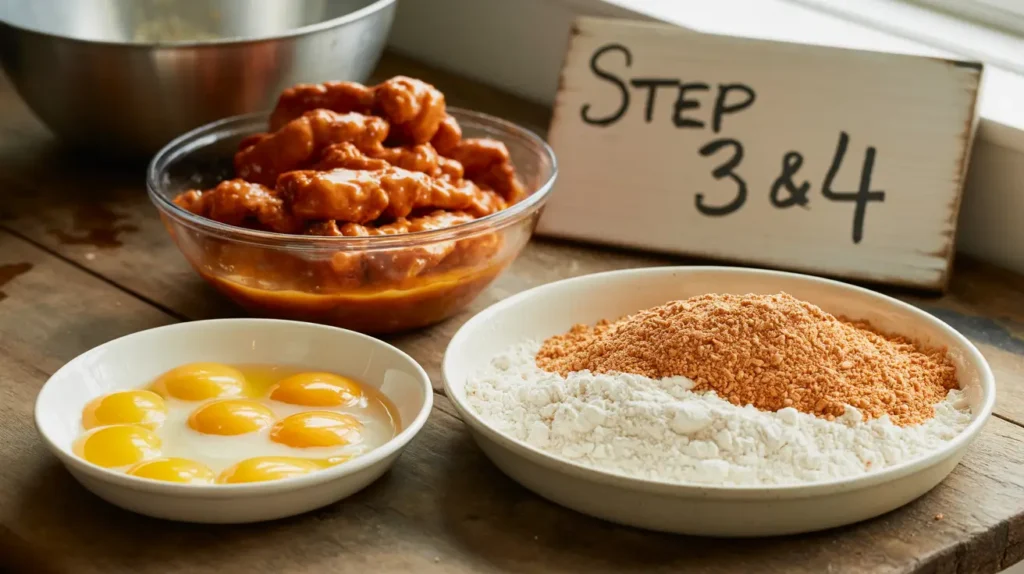
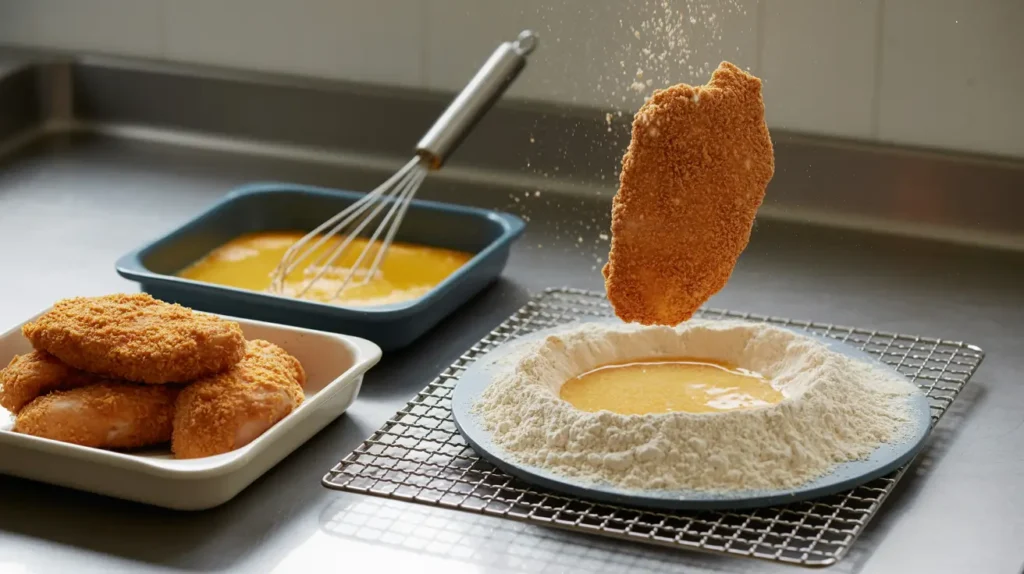

Step 1: Create the Perfect Marinade Base
Begin by combining your chicken tenderloins with buttermilk in a large zip-lock bag or covered bowl. The buttermilk’s acidity works as a natural meat tenderizer, breaking down proteins to create that melt-in-your-mouth texture Dave’s is famous for. Massage the marinade into the chicken, ensuring every piece is completely coated. Refrigerate for a minimum of 2 hours, though overnight marinating will yield superior results.
Step 2: Prepare Your Signature Hot Oil
While your chicken marinates, create Dave’s legendary hot oil blend. In a small saucepan, gently heat your oil over low-medium heat until it reaches about 250°F. Remove from heat and immediately whisk in cayenne pepper, paprika, brown sugar, garlic powder, onion powder, salt, pepper, and ground mustard. The key here is temperature control too hot and you’ll burn the spices, too cool and they won’t bloom properly. Let this mixture cool and intensify in flavor while you prepare everything else.
Step 3: Set Up Your Breading Station
Create an efficient breading assembly line with three stations: your marinated chicken, beaten eggs in a shallow dish, and your flour-cornstarch mixture in another shallow dish. The cornstarch is your secret weapon here it creates an incredibly crispy exterior that stays crunchy even after saucing. Season your flour mixture generously with salt, pepper, garlic powder, and onion powder for maximum flavor impact.
Step 4: Master the Double-Dip Technique
Remove chicken from buttermilk (don’t shake off excess you want that coating). Dip each piece first in beaten eggs, then into the seasoned flour mixture, pressing gently to adhere. For extra crispiness, dip back into eggs and flour mixture again. This double-coating technique creates those satisfying layers of crunch that make Dave’s tenders so addictive.
Step 5: Achieve Perfect Frying Temperature
Heat your frying oil to exactly 325°F this temperature is crucial for achieving golden-brown perfection without burning. Use a candy thermometer for accuracy, as guessing oil temperature is the fastest way to ruin your chicken. If you don’t have a thermometer, test with a small piece of bread it should sizzle immediately and brown within 60 seconds.
Step 6: Fry to Golden Perfection
Carefully add 3-4 pieces of chicken to the oil (don’t overcrowd, which drops oil temperature). Fry for 3-4 minutes per side until golden brown and internal temperature reaches 165°F. The chicken should float when properly cooked, and the coating should be deeply golden and crispy.
Step 7: Apply the Signature Heat
Immediately after frying, while chicken is still hot, brush or toss each piece generously with your prepared hot oil mixture. The residual heat helps the spices adhere and penetrate the coating. For varying heat levels, reserve some plain fried chicken and sauce portions separately to accommodate different spice tolerances.
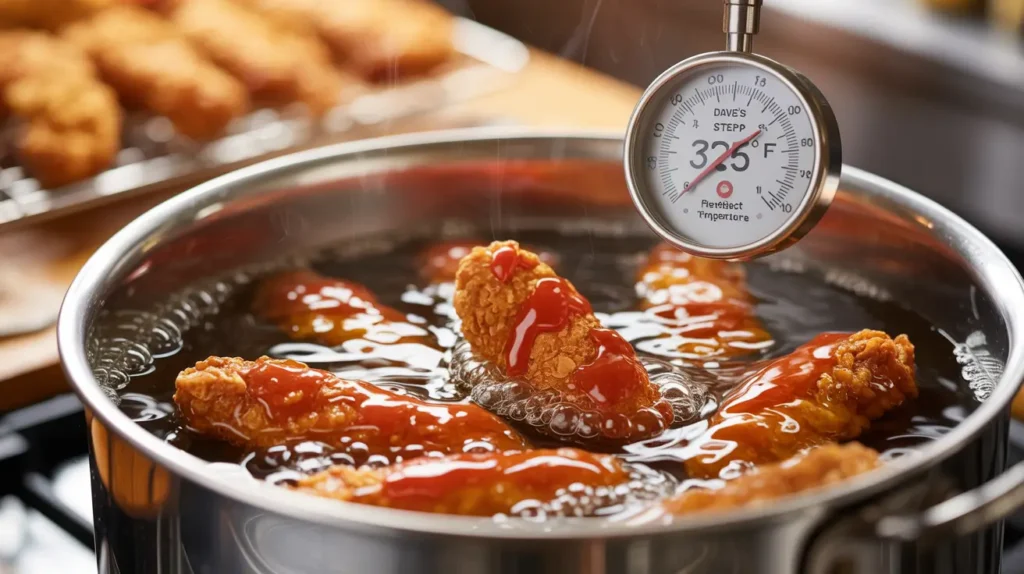
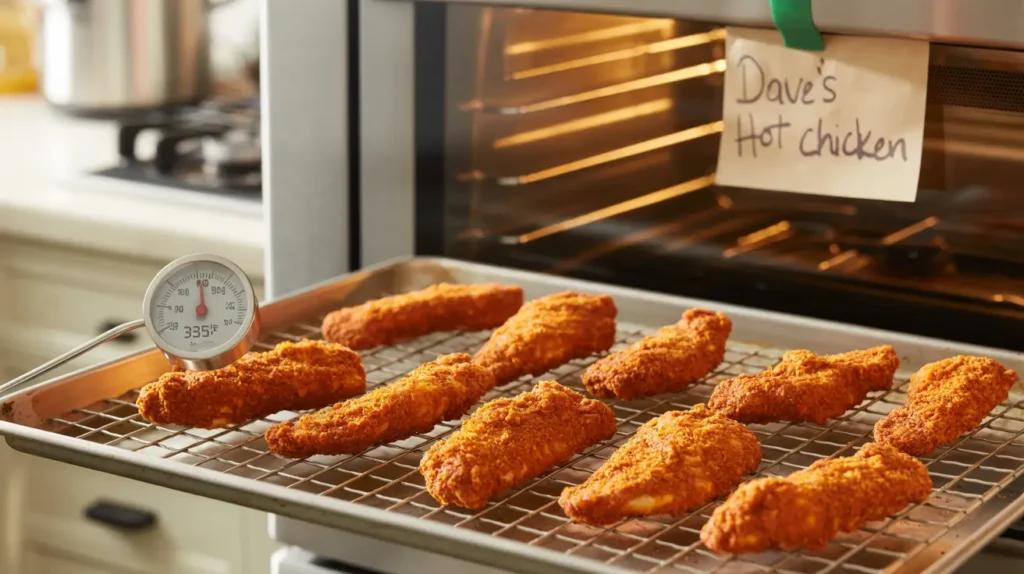
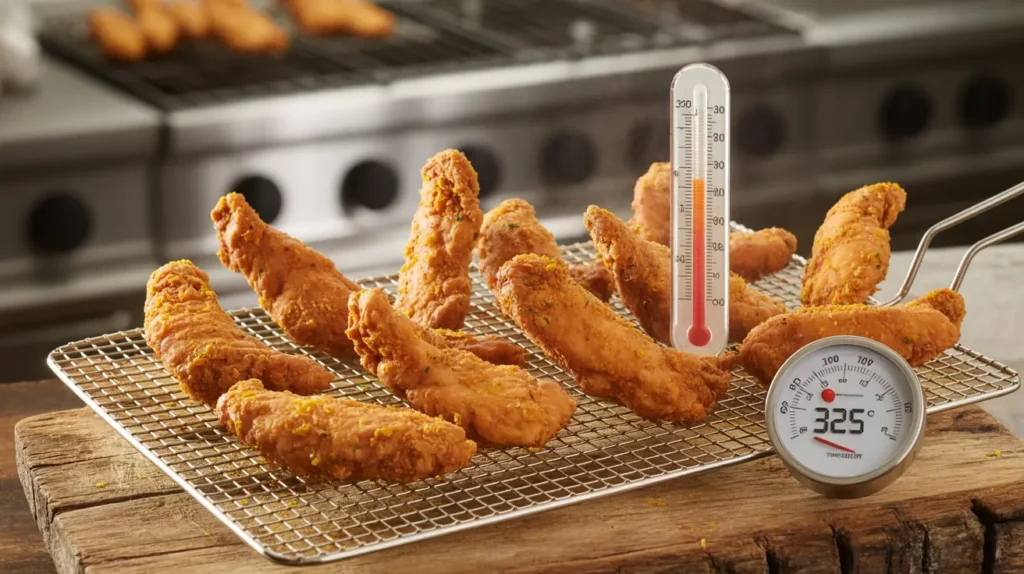
Nutritional Information
Per Serving (4 tenders):
- Calories: 485
- Protein: 35g (70% daily value)
- Fat: 22g
- Saturated Fat: 4g
- Carbohydrates: 28g
- Fiber: 1g
- Sugar: 3g
- Sodium: 890mg
- Cholesterol: 125mg
Key Nutritional Highlights:
- High protein content supports muscle maintenance and satiety
- Moderate carbohydrate level from coating provides energy
- Contains essential amino acids from high-quality chicken breast
- Vitamin B6 and niacin support metabolism and brain function
Health Context: While indulgent, this recipe provides substantial protein and can fit into a balanced diet when enjoyed in moderation. The homemade preparation allows you to control sodium and oil quality compared to restaurant versions.
Healthier Alternatives for the Recipe
Oil Alternatives: Replace traditional frying with air frying at 380°F for 12-15 minutes, flipping halfway through. This reduces oil content by up to 75% while maintaining crispiness. Spray lightly with oil spray for best results.
Flour Substitutions:
- Almond flour + coconut flour blend for keto-friendly version
- Whole wheat flour for added fiber and nutrients
- Gluten-free flour blend for celiac-friendly option
Buttermilk Alternatives: Greek yogurt thinned with milk provides probiotics and extra protein while maintaining tenderizing properties.
Heat Modifications:
- Replace cayenne with smoked paprika for flavor without heat
- Add turmeric for anti-inflammatory properties
- Use honey instead of brown sugar for natural sweetness
Baking Option: Bake at 425°F for 18-20 minutes on a wire rack over a baking sheet, flipping once. Brush with hot oil mixture after baking for authentic flavor.
Serving Suggestions
Transform your Dave’s hot chicken tenders into a complete dining experience with these creative serving ideas:
Classic Nashville Style: Serve over white bread slices with pickle chips and coleslaw. The bread absorbs the spicy oil while providing cooling contrast.
Loaded Chicken Tender Bowl: Create a power bowl with mixed greens, cherry tomatoes, avocado slices, corn, and ranch dressing. Top with sliced hot chicken tenders for a satisfying, balanced meal.
Game Day Platter: Arrange tenders alongside celery sticks, blue cheese dip, buffalo cauliflower, and loaded potato skins for the ultimate sports-watching spread.
Sandwich Perfection: Build incredible chicken sandwiches using brioche buns, mayo, lettuce, tomato, and pickles. Add bacon for extra indulgence.
Family-Style Dinner: Pair with mac and cheese, honey cornbread, green beans, and sweet tea for a Southern comfort food feast that brings everyone together.
Common Mistakes to Avoid
Temperature Neglect: 67% of home frying failures result from incorrect oil temperature. Too low creates greasy, soggy chicken; too high burns the outside while leaving the inside undercooked. Always use a thermometer.
Overcrowding the Pan: Adding too many pieces at once dramatically drops oil temperature and creates uneven cooking. Fry in small batches for consistent results.
Skipping the Marination: Rushing this step results in tough, flavorless chicken. The buttermilk marinade is non-negotiable for authentic texture and taste.
Sauce Timing Errors: Applying hot sauce to cold chicken prevents proper adherence and flavor penetration. Always sauce immediately after frying while chicken is hot.
Flour Mixture Reuse: Using the same flour mixture after raw chicken contact creates food safety risks. Prepare fresh mixture or discard contaminated portions.
Inconsistent Piece Sizes: Varying tender sizes lead to uneven cooking. Cut pieces to similar thickness (about ¾ inch) for uniform results.
Storing Tips for the Recipe
Immediate Storage: Cool completely before refrigerating to prevent condensation that makes coating soggy. Store in single layers separated by parchment paper.
Refrigerator Storage: Properly stored cooked tenders last 3-4 days in the refrigerator in airtight containers. Keep hot sauce separate to maintain coating crispiness.
Freezer Storage: Freeze cooked tenders up to 3 months. Wrap individually in plastic wrap, then place in freezer bags. Label with date and reheating instructions.
Reheating Methods:
- Oven: 375°F for 8-10 minutes until heated through
- Air fryer: 350°F for 3-4 minutes
- Avoid microwaving, which makes coating soggy
Make-Ahead Tips: Marinate chicken up to 24 hours ahead. Prepare hot sauce up to one week in advance. Bread chicken up to 4 hours ahead and refrigerate before frying.
Meal Prep Strategy: Fry tenders on weekends, store properly, and reheat throughout the week for quick, satisfying meals.
Conclusion
Dave’s hot chicken tenders recipe transforms your kitchen into a gourmet hot chicken destination through strategic marination, precise temperature control, signature spice blending, and expert frying techniques. These four homemade tips extended buttermilk marination, cornstarch coating enhancement, temperature precision, and immediate hot sauce application create restaurant-quality results that rival the original.
Ready to ignite your taste buds? Try this recipe tonight and share your spicy success stories in our review section below! Don’t forget to leave a comment about your heat level preference and subscribe for more incredible homemade restaurant recipes that bring professional flavors to your kitchen.
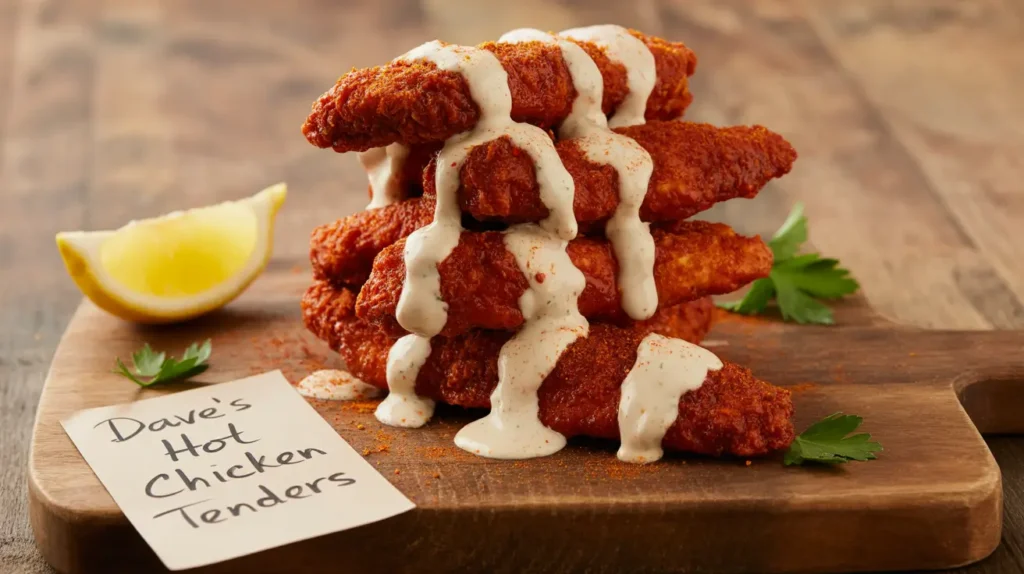
FAQs
Q: Can I make Dave’s hot chicken tenders without buttermilk? A: Yes! Create a buttermilk substitute by adding 2 tablespoons of white vinegar or lemon juice to 2 cups of regular milk. Let it sit for 5 minutes until it curdles slightly. This provides similar tenderizing effects.
Q: How do I adjust the heat level for different preferences? A: Start with 1 tablespoon of cayenne for mild heat, use 2 tablespoons for medium, and 3+ tablespoons for authentic Dave’s-level heat. You can also prepare plain tenders and sauce individual portions to accommodate different spice tolerances.
Q: What’s the best oil for frying these tenders? A: Vegetable oil, peanut oil, or canola oil work best due to their high smoke points and neutral flavors. Avoid olive oil, which has a lower smoke point and can impart unwanted flavors.
Q: Can I prepare these tenders in advance for a party? A: Absolutely! Fry the tenders earlier in the day, store at room temperature for up to 2 hours, then reheat in a 375°F oven for 5-7 minutes before serving. Apply fresh hot sauce after reheating for best results.
Q: Why is my coating falling off during frying? A: This usually happens due to insufficient drying time after breading or oil temperature that’s too low. Pat breaded chicken dry and let it rest for 10-15 minutes before frying. Ensure oil maintains 325°F throughout cooking.
Q: How do I know when the chicken is fully cooked? A: Use an instant-read thermometer to check that internal temperature reaches 165°F. Visually, properly cooked tenders will be golden brown and float to the surface of the oil when done.
Did You Taste Our Best Dishes Yet?
There are no reviews yet. Be the first one to write one.

